Meet the toilet flush cistern
If you are interested in how to adjust the toilet flush tank, then first of all you need to clearly understand its device, since a large range of such devices is similar only in principle, but each of them has different nuances.
Bringing the drain mechanism in working condition can be carried out from the side, by pressure on the lever, either by raising or pressing the rod in the center of the lid. In addition, it may be different and the adjustment of the water level in the tank, the method of discharge (large / small) and so on.
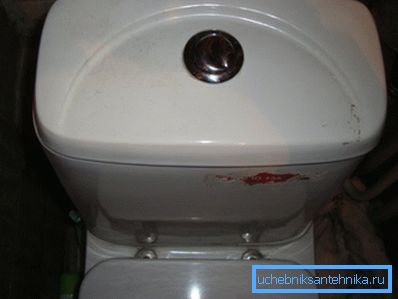
All of this and will be discussed below, as well as to your attention - the video in this article.
These different tanks
General principle of work
Note. Any of the models, regardless of the timing of its design is quite suitable for work. But for all of them there is one main condition - the correct adjustment. Drain tanks of the new type with factory default settings do not need adjustment, although this is quite possible if necessary.
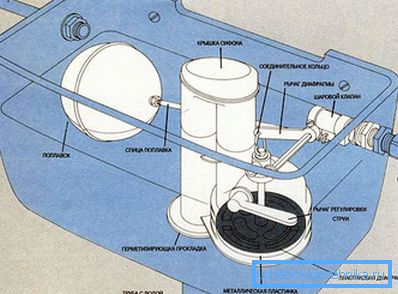
- As already noted at the beginning of this article, a variety of models of containers used for flushing the toilet does not affect the general principle of operation for several decades already - water continues to enter the toilet through the drain valve and its level is regulated by a float. In addition, the instruction in any case requires that the water tank is only on top and it can be located on the dish-shaped stand of the toilet itself, on the wall, under the ceiling or in a niche, inside the wall - but, in any case, on top.
- Also, the flushing mechanism for a toilet cistern or valves, as it is also called, always provides access to water and filling the tank in an automatic mode, without any outside intervention, although the level can be adjusted in any of the models. Control (drain) is carried out only manually, using a knob, button or key, which lifts the shut-off valve and the tank is emptied completely or partially. After a certain amount of water flows through the siphon into the toilet, the exhaust valve is in its original position and the tank is refilled to the desired limit.
- The water level in the initial state or adjustment of the cistern of the toilet bowl of any sample is made with the help of a float, which is connected with a lever to a shut-off valve in the water supply. The float always floats on the surface and when the water level rises, it also rises along with the lever and at a certain moment the lever brings the valve to the closed position - after that the water supply stops.
Older models

If we talk about the distinctive features of the models of the old sample, here, perhaps, you can name the main defining features by which you can determine the belonging of the cistern to the old generation.
- First of all, It is a cast iron or earthenware container.
- Secondly, lateral (occasionally central) location of the lever for draining water.
- Thirdly, only side water inlet.
If we consider that earlier a bathroom (especially in the Soviet Union) was always considered a utilitarian-type room, then the design was of no interest to anyone at all, therefore, all models of that time are completely devoid of any frills. Valves such a tank consists of a simple drain mechanism and the same simple machine that regulates the flow of water into the tank.

In this case, the discharge of water is provided by a simple design, which is a wide discharge siphon with a rubber or plastic valve, which in its form is very similar to a plumbing plunger.
The stem from this valve is usually brought to the side handle, with which it rises to allow water to flow into the hole. The closed state of the valve is stabilized by the influence of gravitational forces.
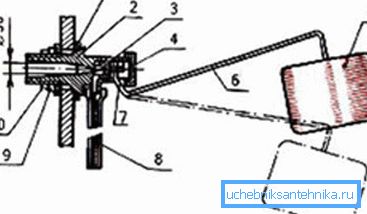
As water arrives in the tank, the float rises, dragging the metal lever, which in turn exerts pressure on the shut-off valve.
That is, this valve is gradually supplied to the orifice from which water flows and at the last moment closes this orifice completely. After the water is released from the tank, the float goes down, dragging a lever with a valve, and the whole process is repeated anew.
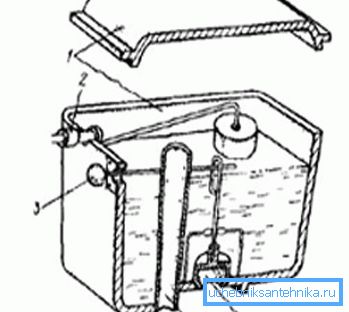
Despite the fact that such equipment, as you can see in the upper image, is rather cumbersome, it is extremely reliable in operation - in some apartments such tanks stood for about 50 years without any repairs, although there was a minor preventive maintenance.
This was possible due to the absence of small springs and plastic parts, which eventually become useless, which can be observed in modern models.
Single Button Models
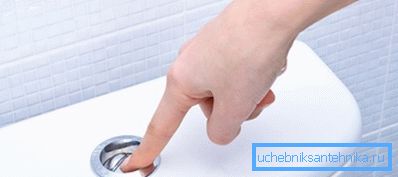
Drain cisterns for toilet bowls, in which the process itself is started by pressing the button on the center of the lid, look, of course, much more attractive than similar containers equipped with a side lever or a central, rising stem with a ball above the lid. As we have already said, the water-intake mechanism here also consists of a float with a lever pressing on the shut-off valve at the water supply opening (see also the article “Old-style toilet cisterns” —the features of their design and recommendations for repair work).
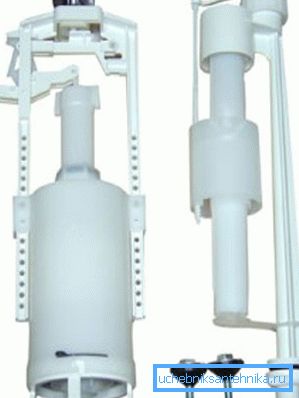
But in new models this device was replaced by a ball valve, which makes this adjustment, and the whole mechanism is a single unit of a button, a stem and a valve (ball valve).
On such a block there is a thread, with the help of which it is installed in the drain siphon, and it is also equipped with a hole for water discharge in case of failure of the shut-off valve (tap) at the flow. The lever, which is connected to the button, functions according to the principle of the reverse mechanism, that is, with pressure down, the valve rises.
Note. Fixing the valve in the closed state here, as in the tanks of the old model, is possible under the influence of gravitational forces.
Such constructions have one indisputable advantage and it’s not even the factory settings, no, this is a modular repair. That is, if the drain mechanism fails, you simply remove it from the drain tank and go with it to the store.
A plumber who sells plumbing - the seller will easily select the desired modification of the device, especially since its price is 4 times less than the cost of a new flush tank. It does not make sense to engage in the repair of such mechanisms - they are designed for one-time use and intervention in functionality is acceptable only for adjusting the float (the water level in the tank in the filled state).
Model with two buttons
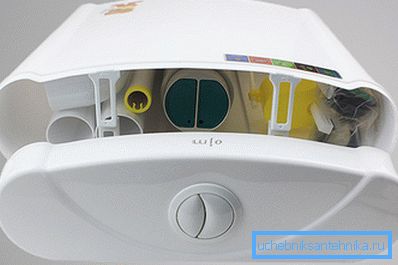
Recently, a toilet with a flush tank according to GOST 30493-96 with two buttons, each of which allows you to use a certain amount of water when draining, has become increasingly in demand.
Such devices have gained popularity not only in residential areas, but also in cafes, restaurants and other public institutions. Since the right (targeted) use of buttons consumes the minimum amount of water, therefore, this affects the budget allocated to utilities.
That is, in this case, it is possible to spend two different volumes of water, and if with one button you drain 7-8 liters of water, then with the other you will reduce this volume to 3.5-4 liters.
Note. If we talk about the identification characteristics, the dual-mode models are easy to recognize by the presence of two buttons or keys in the very center of the cover. To determine the amount of water discharged, as a rule, they are guided by their size - which one is larger, there is also a larger volume of liquid discharged.
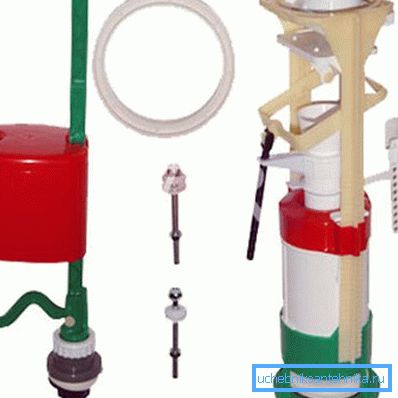
The one-piece non-separable drain valve body, which in height occupies almost the entire space from the lid to the bottom of the flush cistern, is almost the same as the one-button mechanism.
Installing such a mechanism with your own hands is also no different from a single-mode system - the same mounting with internal or external thread and the same system of the inlet valve for a set of water in the tank.
But here there are two levers of the slider type, with the help of which you can set the mode of small drain, that is, adjust the amount of water discharged into the toilet.
But it is precisely such adjustment that may not be on every mechanism, since each manufacturer makes its own improvements and there is simply no possibility to list them all. Repair of real valves also does not make sense, as in single-button devices, therefore, in case of failure, the module is simply replaced modularly.
Note. For public institutions, the most common is the double mechanism, where volume adjustment is absent, that is, the work takes place in the default mode from the manufacturer. But for private houses or apartments, such tanks or shut-off valves separately does not matter much in terms of economy - it is too insignificant.
Adjustment
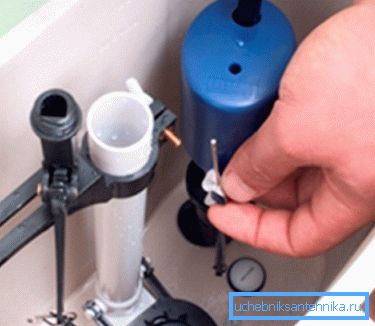
The consumption of water that you receive at the end of the month in your apartment is approximately 50% dependent on the frequency of using the toilet and only 25% on drinking, food and washing dishes and another 25% on a shower or bath. But you can always adjust these costs yourself, if you adjust the drain tank on your own.
The average consumption of a large drain is about 7-8 liters of water, but it can be done more or less by setting the float to a certain height, as shown in the top photo.
From the material above, you realized that the float is directly connected to the shut-off valve to supply water to the tank, therefore, the lower you lower it, the faster this valve will close and the water in the tank will accumulate less.
In modern models, the float can be moved along a ribbed bar, leaving it in the desired position, and in old models you can simply bend metal cravings to change the level.
Conclusion
You probably understand that one flush tank may differ from another, and the adjustment of the mechanism will also have its differences, but the principle will still remain in giving a float of a certain level. When choosing a tank, pay attention to the location of the hole (from which side) for the water supply in accordance with the possible option of installing a toilet bowl with your own hands.